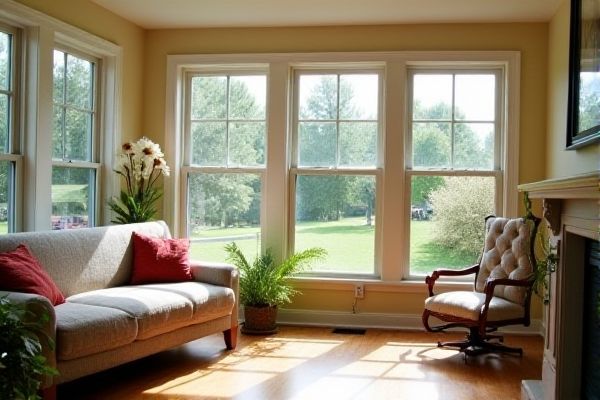
Single-pane sunroom windows offer basic insulation and affordability but often fall short in energy efficiency and noise reduction compared to double-pane versions. Exploring the benefits and drawbacks of each option can help you make an informed decision for your sunroom's comfort and cost-effectiveness--read on to discover which choice suits your needs best.
Table of Comparison
| Feature | Single-Pane Windows | Double-Pane Windows |
|---|---|---|
| Insulation | Low insulation, higher heat loss | High insulation, reduces heat transfer |
| Energy Efficiency | Low energy efficiency | Improves energy efficiency by up to 50% |
| Noise Reduction | Poor noise reduction | Better soundproofing capability |
| Condensation | Prone to condensation buildup | Less prone due to sealed airspace |
| Durability | Less durable, easier to break | More durable and sturdy |
| Cost | Lower upfront cost | Higher initial investment |
| Lifespan | Shorter lifespan | Longer lifespan, better long-term value |
| UV Protection | Minimal UV blocking | Enhanced UV protection features |
Introduction to Sunroom Window Options
Single-pane sunroom windows provide basic insulation but are less energy-efficient compared to double-pane options that feature two layers of glass separated by an air or gas-filled space. Double-pane windows significantly reduce heat transfer, improving temperature control and lowering energy costs in your sunroom. Choosing double-pane windows enhances comfort and durability, making them a superior option for year-round use.
What Are Single-Pane Sunroom Windows?
Single-pane sunroom windows consist of a single layer of glass that allows natural light to enter while providing minimal insulation against temperature fluctuations. These windows are more affordable and lightweight but often result in higher energy costs due to poor thermal efficiency. Choosing single-pane windows affects your sunroom's comfort by offering less protection from outdoor noise and weather extremes compared to double-pane alternatives.
What Are Double-Pane Sunroom Windows?
Double-pane sunroom windows consist of two layers of glass separated by a spacer filled with insulating gas, such as argon or krypton, enhancing thermal efficiency compared to single-pane windows. This design significantly reduces heat transfer, minimizing energy loss and improving climate control within the sunroom. Double-pane windows also provide better sound insulation and reduce condensation, extending the lifespan of the window frame and improving overall comfort.
Energy Efficiency: Single-Pane vs Double-Pane
Double-pane sunroom windows provide superior energy efficiency by trapping air or gas between two glass layers, significantly reducing heat transfer compared to single-pane windows. This insulation minimizes your home's heating and cooling costs while maintaining a comfortable indoor temperature year-round. Choosing double-pane windows enhances your sunroom's energy performance, making them an eco-friendly and cost-effective investment.
Insulation and Comfort Differences
Double-pane sunroom windows provide superior insulation with two layers of glass separated by a gas-filled space, significantly reducing heat transfer and improving energy efficiency. Single-pane windows lack this insulation, resulting in higher heat loss during winter and increased heat gain in summer, which can make your sunroom less comfortable year-round. Choosing double-pane windows enhances temperature regulation and reduces outside noise, creating a more pleasant and energy-efficient space.
Noise Reduction Comparison
Double-pane sunroom windows offer superior noise reduction compared to single-pane windows due to the insulating layer of air or gas between the panes, which dampens sound transmission. Single-pane windows lack this additional barrier, making them less effective at blocking external noise. Homeowners seeking a quieter sunroom environment benefit significantly from the enhanced acoustic insulation provided by double-pane designs.
Cost Considerations: Upfront and Long-Term
Single-pane sunroom windows typically have lower upfront costs but tend to increase energy expenses over time due to poor insulation. Double-pane windows, though more expensive initially, provide better thermal efficiency, reducing heating and cooling costs significantly in the long term. Investing in double-pane glass enhances overall home energy savings and can improve property value by minimizing heat loss and condensation.
Maintenance Requirements for Each Type
Single-pane sunroom windows demand frequent maintenance due to their susceptibility to temperature fluctuations, often requiring regular sealing and repainting to prevent drafts and condensation. Double-pane sunroom windows offer reduced maintenance needs as their insulating gas layer minimizes condensation and thermal stress, resulting in less frequent seal repairs or glass replacement. Homeowners benefit from lower upkeep costs and improved window longevity with double-pane options compared to single-pane alternatives.
Durability and Lifespan
Double-pane sunroom windows offer superior durability and a longer lifespan compared to single-pane windows due to their insulated glass units, which reduce condensation and resist thermal stress. Single-pane windows are more prone to cracking and warping, especially in extreme weather conditions, leading to frequent repairs or replacements. Investing in double-pane windows enhances the structural integrity and energy efficiency of a sunroom, ensuring lasting performance over decades.
Choosing the Right Window for Your Sunroom
Single-pane sunroom windows offer basic insulation but often result in higher energy costs and less noise reduction compared to double-pane windows, which feature two layers of glass separated by an insulating gas or air space. Double-pane windows enhance thermal efficiency, reduce condensation, and improve comfort by minimizing heat loss in winter and heat gain in summer. Choosing the right window for your sunroom depends on your climate, budget, and how much energy savings and noise reduction you prioritize for your space.
 homyna.com
homyna.com